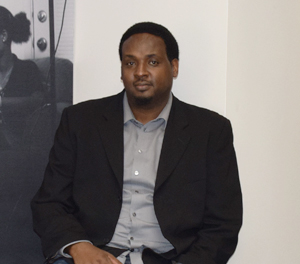
Kizito Kalima
After a survivor gives his or her testimony to the USC Shoah Foundation, what happens next?
If you’re like Kizito Kalima, you come back to the Shoah Foundation four years later to find out.
Kalima survived hiding, attempted mass executions and the deaths of many family members as a child during the 1994 Rwandan Tutsi Genocide. He recorded his testimony in 2010 from his home in Indianapolis, where he lives with his wife and their two adopted daughters, who are also survivors of the Rwandan Tutsi Genocide.
Today, Kalima is a case manager and frequently speaks publicly about his experiences. While in Los Angeles for a family reunion, Kalima visited the USC Shoah Foundation office to meet the staff and find out more about how his testimony is being preserved and used to educate students about genocide.
During his visit, Kalima visited the ITS office and high-tech facility where USC Shoah Foundation’s 53,000 interviews are preserved, catalogued and made available to millions of viewers worldwide.
He then met with the education staff, who demonstrated IWitness, USC Shoah Foundation’s interactive, educational website that teaches students about genocide and tolerance through testimony.
Kalima is featured prominently in IWitness. Students can watch Kalima’s entire testimony, and there is also an Information Quest activity in which students watch several clips from Kalima’s testimony and respond to them.
In addition, the USC Shoah Foundation website offers a lesson guide for teachers called “If You Survive, Be a Man: Teaching the 1994 Rwandan Genocide of the Tutsis” that includes several clips from Kalima’s testimony.
Ever since he first began talking about the genocide as a high school student, Kalima has seen and experienced firsthand the benefits of sharing his life story with others. IWitness, he said is a great tool to help people learn about what happened.
But Kalima said this visit was the first time he had ever seen IWitness, and his testimony, in action, teaching students about genocide. He said he’s glad that the testimonies show kids the causes and consequences of genocide, and that many testimonies set a positive example by showing how survivors have been able to move on after their ordeal.
“I had heard about IWitness, but I didn’t know how it works. I never got the chance to see how kids use [testimonies], choosing which clips they want to watch,” Kalima said. “[To see my testimony in IWitness] is humbling and exciting. It’s my dream.”